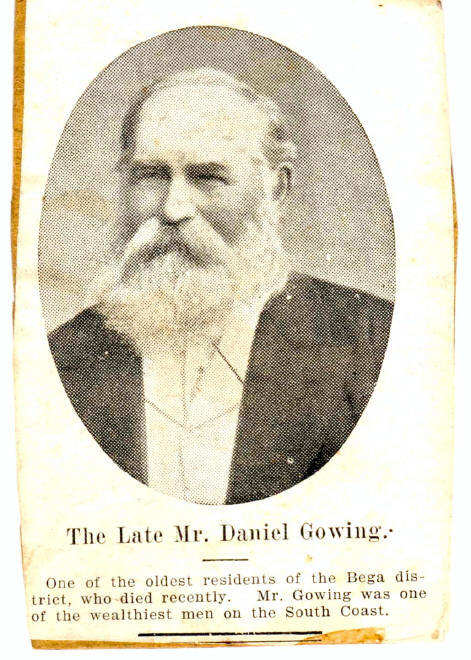
Home | Pioneers | Contact Us | Copyright/Disclaimer
 |
| Photo supplied by Barbara Adams [davida8-at-bigpond.com] 14.04.08 |
DANIEL GOWING (1812-1906)
Copied by Barbara Adams (Barbara Adams [davida8-at-bigpond.com]) from Bega’s century of progress 1857-1957
He was Grandfather’s friend ( Joshua John Britten)
So much of the history of the Bega district runs parallel with the careers of Daniel Gowing 1812-1906 and Charles McGregor 1830-1921 that a review of their lives in this publication is essential.
Both men find a special place in the history of the Bega Show Society through their winning efforts as ploughing experts of their day when they won the first two ploughing matches. The first recorded events ever held in the first attempt at a show in 1857.
Dan Gowing was one of the British pioneers who did much to develop the natural resources of the Bega district.
He was born in Saxingham, Norfolk England in 1812. After working as a Hedger and Thatcher in Norfolk, he left England with his wife Mary and two children in 1841 on the ship “Elizabeth” when comfortable voyages were unknown and took 100 to 140 days to Sydney With little money in his pockets, he first settled at Bong Bong and Sutton Forest where he carried on a farm and took his produce several miles to market on a wheelbarrow, horses and carts being uncommon. After some cattle dealing and thrifty saving he bought a Monaro Property in the vicinity of the Snowy River. Distance from communications led him to ride down from Monaro to examine the coastal country, and he selected the rich flats of Jellat Jellat, where, at the first land sale, he bought 500 acres which he called “The Garden of Eden” By good management he added to his selection, acquiring all the land from the river to Black Range and became one of the wealthiest men on the coast. He was an expert farmer and gardener and built himself a fine residence hot houses and cultivation paddocks His garden proving him the leading district horticulturist of his day.
Progressive farming methods were followed and year by year up to date machinery was added to the estate His traction engine( The first in the district) and “turn-wrest”plough turned ten acres a day and he acquired a steam launch for use on the River. He assisted in constructing the first road to Kianinny and chartered sailing vessels to call for his produce. He also built the first store at “Tarthra” where schooners called, thus replacing Merimbula as Bega’s port. As years passed he acquired considerable property in Bega including the Central Hotel.
Maize crops played the most important part in building his fortune, although at first he grew wheat and erected the second flour mill in the district on his property at Jellat. Steam was used to drive the mill, the horse mill at Corridgeree being used to that time.
In the drought of1885-6 his was the only corn which could be bought to the district. People speaking of a visit to his farm “as a visit to Egypt” Large stores were built where maize was held for high prices. Several prizes were secured for maize in the International Exhibition at AMSTERDAM IN 1883 London 1886 and Sydney In 1886 he went home to England in the “Zelandi” returning in the”Shannon”
While building his own fortune he did not forget the welfare of his district. And he was a keen supporter of all Public movements He opened the first North Bega Bridge in 1878
He was a member of the first National School Board, Hospital and Agricultural Societies Committees.
Garden parties at his home for Bega Charities and also picnics for the school children in his orchard were an annual event.
The hospitality of Daniel Gowing’s home was extended to all visitors.
He was also chairman of trustees of Tathra wharf, and for many years vice president of the A.P. and H society.
His public spirited and philanthropic nature led him to donate the land in Peden Street for the Benevolent Society’s Victoria Homes two of which he erected at his own expense
When guarantors were required to set the Bega Co-Op Creamery Company on foot, Daniel Gowing with John D’Arcy came forward and gave the necessary guarantees at the bank.
After a long life of great achievement, during which he saw the whole of Queen Victoria’s record reign, he died in 1906 at the great age of 93 years and nine months and was buried in the Church of England portion of the old Bega Cemetery.
His work has been carried on by three sons and four daughters of his first wife and their
Descendants, the name of Gowing being widely known and respected throughout the district to this day
Copied by B. Adams from the “Story of Bega by courtesy of W. A. Bayley
|